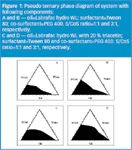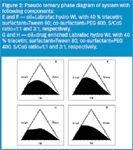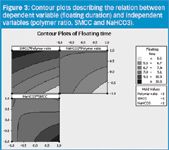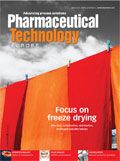SMEDDS incorporated polymer matrix: A floating dosage form solution for drugs with poor gastric solubility
Pharmaceutical Technology Europe
A new kind of gastro-retentive dosage form for drugs with poor aqueous solubility was developed and evaluated, with the aim of achieving gastro-retention.
Furosemide (FUR) is a high-loop diuretic widely used for the treatment of conditions leading to excessive accumulation of water in the body (edema), which are normally associated with cardiovascular disorders such as heart failure, infarction and hypertension. It has been reported that FUR has a bioavailability problem and initially shows an adverse temporary peak diuretic effect.1,2 To eliminate this, various efforts have been made to develop prolonged-release forms of FUR; however, it has been reported that the bioavailability of such preparations decreases to 40–60% compared with conventional tablet forms.1
Although it has not been demonstrated for humans, animal studies of bioavailability have shown that there may be regions in the stomach and/or the upper part of the small intestine where FUR is specifically absorbed; the short stay of controlled release preparations in this specific region of absorption leads to bioavailability problems.3 Accordingly, developing a floating dosage form with a controlled release pattern aimed at prolonging the residence of FUR at the site of maximum absorption (upper gastro intestinal tract (GIT)) has been proposed as an option for improving bioavailability and, at the same time, reducing the side effect of peak diuresis associated with conventional formulations.4 However, formulating a gastro-retentive dosage form of FUR poses a great challenge because of FUR's insufficient aqueous solubility in acidic mediums (pH 1.2), which may be considered the rate-limiting step in the absorption process.5,6

OJO Images/Getty Images
The present work was conducted to develop a novel floating dosage form of FUR to enhance its solubility by formulating a self microemulsifying drug delivery system (SMEDDS) of FUR, followed by its adsorption onto a mixture of high functionality excipient (SMCC), matrix forming polymers (HPMC K4M and HPMC E50 LV) and a gas-generating agent (NaHCO3) to achieve a buoyant matrix with a controlled release profile.
Materials and methods
Materials
FUR was obtained from Aarti drugs (India). The following materials were donated by Gattefosse (India) and were used as received: Labrafac CM10 (C8‑C10 polyglycolized glycerides), Masine 35-1 (Glyceryl momolinoleate), Lauroglycol FCC (Propylene glycol laurate), Labrafil 1944 CS (Apricot kernel oil PEG 6 esters) and Labrafac PG (Propylene glycol caprylate/caprate). Cremophor RH 40 (Polyoxyl 40 Hydrogenated castor oil), Cremophor EL (polyethoxylated castor oil) and Solutol HS 15 (Polyoxyethylene esters of 12-hydroxystearic acid) were obtained from BASF (India). Gelucire 44/14 (PEG‑32 glyceryl laurate), 50/13 (PEG‑32 glyceryl palmistearate) and Triacetin (glyceryl triacetate) were received from Colorcon Asia (India). Span 20 (sorbitan monolaurate), Tween 80 (polyoxyethylene sorbitan mono-oleate), PEG 400 and sodium bicarbonate were bought from Merck Co (India). Silicised microscrystalline cellulose ProSolv SMCC was received from DMV International (India). Grades of hydroxypropyl methylcellulose (HPMC K4M and HPMC E50 LV) were received as gift samples from Colorcon Asia. Deionised water was prepared using a Milli‑Q purification system from Millipore (France).
Acetonitrile and methanol used in the study were of HPLC grade. All other chemicals were reagent grade. Empty hard gelatin capsule shells were donated by ACG capsules (India).
Solubility studies
The solubility of FUR in various components (oils, surfactants and cosurfactants) was determined and 500 mg of each of the selected vehicles were added to each cap vial containing an excess of FUR (1 g). After sealing, the mixture was heated at 40 °C in a water bath to facilitate solubilisation. Mixing of the systems was conducted using a vortex mixer and the formed suspensions were then shaken with a shaker at 25 °C for 48 h. After reaching equilibrium, each vial was centrifuged at 3000 rpm for 5 min and excess insoluble FUR was discarded by filtration using a membrane filter (0.45 µm, 13 mm; Whatman, USA). The concentration of FUR was then quantified using HPLC.
Pseudo-ternary phase diagram
The pseudo‑ternary phase diagrams of oil, surfactant/cosurfactant (S/CoS) and water were developed using the water titration method; the mixtures of oil and S/CoS at certain weight ratios were diluted with water in a dropwise manner. For each phase, diagrams at a specific ratio of S/CoS, 1:1 and 3:1 (w/w), a transparent and homogenous mixture of oil and S/CoS was formed under the mixing by vortexing for 5 min. Each mixture was then titrated with water and visually observed for phase clarity and flowability. The concentrations of water at which turbidity‑to‑transparency and transparency‑to‑turbidity transitions occurred were derived from the weight measurements, and these values were then used to determine the boundaries of the microemulsion domain, corresponding to the chosen value of oils, as well as the S/CoS mixing ratio. The effect of adding triacetin to oil phase‑on‑phase behaviour of the mixture was also studied. To determine the effect of drug addition on microemulsion boundary, phase diagrams were also constructed in drug presence, wherein the oil component was enriched with the drug. Phase diagrams were then constructed using Tri plot v1‑4 software.7
Preparation of SMEDDS
SMEDDS were prepared using Tween 80 and PEG 400 as the S/CoS combination, and Labrafac Hydro WL (with 40% triacetin) as the oil component (Table 1). In all formulations, the level of FUR was kept constant (10% (w/w) of the total formulation weight). Briefly, accurately weighed FUR was placed in a glass vial followed by the addition of oil and S/CoS, and the components were then mixed by gentle stirring and vortex mixing, and heated at 40 °C using a magnetic stirrer until the FUR was perfectly dissolved. The formulations were then subjected to three to four freeze thaw cycles, which included freezing at –4 °C for 24 h, followed by thawing at 40 °C for 24 h. The formulations were then observed for phase separation. Only formulations that were stable to phase separation were selected for further studies.

Table 1: SMEDDS formulations.
Emulsion droplet size analysis
SMEDDS formulation (100 µl) was diluted to 250 mL in a beaker and gently mixed using a glass rod. The resultant emulsion was then subjected to particle size analysis, using a Malvern Meta‑sizer equipped with 2000 Hydro MU (Malvern, India] with a particle size measurement range of 0.02–2000 µm. Particle size was calculated from the volume size distribution and all studies were repeated in triplicate, with good agreement being found between measurements.
Assessment of self emulsification
The evaluation of self‑emulsifying properties was conducted using visual assessment, as previously reported.8 In brief, visual assessment was performed by drop‑wise addition of the preconcentrate (SMEDDS) into 250 mL distilled water. This was done in a glass beaker at room temperature and the contents were gently stirred magnetically at approximately 100 rpm. Compositions were then categorised on speed of emulsification, clarity and apparent stability of the resultant emulsion.
In vitro dissolution studies
The quantitative in vitro release test was performed in 900 mL of buffer pH 1.2, using USP XXIII Type 1 apparatus, at 37 +/- 0.5 °C. The basket shafts were rotated at 50 rpm. The SMEDDS formulation was filled in hard gelatin capsules (1 size) and used for drug release studies to compared with plain FUR. During the release studies, 5 mL sample of medium was taken out and subjected to drug analysis using HPLC. The removed volume was replaced each time with fresh buffer pH 1.2. For determining the in vitro dissolution of plain FUR, the medium was changed to 900 mL of buffer pH 1.2 with Tween 80 (equivalent to the amount used in formulation). Similarly, dissolution studies were also conducted in other mediums (buffer pH 4.5 and 7.2) to observe the effect of pH on drug release.
HPLC analysis of FUR
FUR concentration in the samples was determined by HPLC analysis. The HPLC analysis system consisted of Jasco PU 980 Intelligent pump (Jasco Pumps, India) and Jasco MD‑2015 plus multi‑wavelength detector. The chromatographic column was a C‑18 Lichrosphere 10RP-18e (5 µm) 4.6 mm x 250 mm (Merck, India). The chromatographic conditions were:
- mobile phase: methanol: 0.01 M KH2PO4 (37:63)
- flow rate: 1 mL/min; loop size: 100 µL
- detection at 274 nm and retention time 9.0 +/- 9.5 min.
The validation parameters were:
- linearity (range = 5–30 µg/mL, coefficient of correlation = 0.9999)
- limit of detection = 126 ng/mL
- limit of quantification = 420 ng/mL.
Preparation of floating dosage form
Selection of components
Various components were screened based on their efficiency of adsorption and flow properties. The adsorption efficiency was determined by mixing the individual components with SMEDDS in 1:1 w/w ratio and evaluating the characteristics. The SMEDDS adsorbed mixtures were evaluated for angle of repose,9 carr's index10 and hausner's ratio.11
Experimental design and analysis
Twenty three full factorial design was employed to optimise the quantity of components required for formulation with desired floating duration and drug release characteristics. The ratio of HPMC E50 LV and HPMC K4M, amount of NaHCO3 and amount of SMCC were selected as independent variables X1, X2 and X3, respectively. Floating time (YA) and dissolution fit factor (YB) were chosen as the dependent variables. In this design, the three independent factors were evaluated at two levels and experimental trials were performed at all possible combinations. For accuracy, experiments were conducted in duplicate.
Batches for experimental trials were prepared and evaluated for floating duration and dissolution studies. Drug release pattern with constant release during a period of 8 h was selected as reference and the floating duration of 8 h was selected as the required parameter. The dissolution fit factor was calculated by evaluating the inter-relationship of release pattern of each developed formulation with the reference release pattern using the Moore equation (Equation 1).12

The nonlinear computer-generated quadratic model is given in Equation 2, where Y is the measured response associated with each factor level combination; b0 is an intercept; b1 to b33 are regression coefficients computed from the observed experimental values of Y; and X1, X2 and X3 are the coded levels of independent variables. The terms X1X2 and Xi2 (i = 1, 2 or 3) represent the interaction and quadratic terms, respectively. Statistical evaluation of the effects of factors on the performance of dosage form was studied by applying one-way analysis of variance at 0.05 level, using MINITABS 15 software (Minitab Ltd, UK). F-statistic was applied to obtain a reduced equation by neglecting non-significant (p > 0.05) terms.

Preparation and evaluation of floating drug delivery system
The matrix based gas generating floating drug delivery system was developed by adsorbing the SMEDDS formulation on to the required amount of powder mixture, which comprised HPMC polymers, SMCC and NaHCO3. The amounts required were optimised based on the results obtained from factorial design. Formulation was filled into a hard gelatin capsule (0 size) for further evaluation using a manual capsule filling machine (GMP model; Grovers International, India). Capsule size (0) was selected to limit the volume capacity to achieve a compact fill in the capsule.
Evaluation of floating dosage form
Buoyancy determination
In vitro floating time was determined in both pH 1.2 (fasted state) and pH 4 (fed state) in both stagnant and disturbed (under magnetic stirring) conditions using a magnetic stirrer at 50 rpm. Capsules were placed in 250 mL of medium and observed for floating duration.
In vitro dissolution
In vitro dissolution study was conducted using USPXXIII type I apparatus in 900 mL of medium (pH 1.2 and pH 4.0). Formulations were subjected to a dissolution rate test for 8 h and the amount of active released was measured spectrophotometrically at a wavelength of 274 nm using a Jasco 530 S Spectrophotometer (Jasco, Japan). The dissolution release data were then analysed using various models (Zero order, First order, Higuchi, Korsmeyer & Peppas, Hixon Crowell and Weibull),13–18 and the results were utilised to explain the mechanism of the release of active material from the formulation.
Stability studies
To check the stability of the developed formulation, the optimised batch was subjected to stability studies as per ICH guidelines. The samples were stored in stability chambers (Thermolab, India) and stability data were collected over a period of 12 months for long-term study (25 °C/60% RH) and 6 months for accelerated conditions (30 °C/65% RH and 40 °C/75% RH).
Results and discussion
Selection of components for SMEDDS
One important consideration when formulating a self emulsifying formulation is to avoid precipitation of drug in vivo.19 The prerequisite for this is that the components used in the system should have a high solubilisation capacity for drug, ensuring the solubilisation of drug in resultant dispersion.20 Among all the oils tried in the study, Labrafac Hydro WL showed the highest solubilisation capacity for FUR (61.2% w/w). Tween 80 and PEG 400 also showed good solubilisation (79.9% and 68.7% w/w, respectively) and thus were selected as surfactant and co-surfactant, respectively. Triacetin showed the highest solubilisation (82.1% w/w) among all the components tried and was, thus, included in the formulation as a cosolvent.

Figure 1
Pseudo-ternary phase diagram
In the present study, Labrafac was tested for ternary diagram studies with Tween 80 and PEG 400 as S/CoS mixture in the presence of triacetin (20% and 40%). As seen from the ternary plot (Figure 1 and 2), the microemulsion existence area increases with the increasing ratio of S/CoS mixtures with wider area for 3:1, compared with 1:1 w/w S/CoS. Increasing the triacetin concentration in the formulation resulted in a wider microemulsion existence field compared with combinations containing no or lower amounts of triacetin. Thus, it could be assumed that triacetin showed some co-surfactant property. Further, it was found that the inclusion of drug narrowed the microemulsion existence area, which can be attributed to the inclusion of drug in lipid phase leading to increased droplet size and, consequently, the requirement of a higher amount of S/CoS for stabilisation.

Figure 2
Droplet size analysis
The droplet size distribution of various formulations is given in Table 2. Increasing the proportion of triacetin in lipid phase (Labrafac hydro WL) resulted in a proportional decrease in particle size. It was also seen that a 1:1 proportion of triacetin containing oil and S/CoS was found to be ideal, showing no precipitation on dilution (Batch E). Because the main aim was to adsorb the SMEDDS composition on polymer mixture to develop a floating dosage form, attempts were made to keep the total weight of SMEDDS to a minimum. Thus, the components were progressively decreased to obtain a composition with minimum weight; however, it was seen that decreasing the weight below 280 mg (Batch G) resulted in an ineffective formulation that showed precipitation on dilution. This could be attributed to increased surfactant proportion relative to co-surfactant, as it is reported that the addition of surfactants to the microemulsion systems causes the interfacial film to stabilise and condense, while the addition of co-surfactant causes the film to expand.21,22 Thus, Batch G was selected as the final composition.

Table 2: Evaluation parameters of various formulations.*
Self emulsification and in vitro dissolution studies
The results of self emulsification studies are also given in Table 2. It can be seen that an increase in the proportion of triacetin in the composition resulted in decreasing the self emulsification time. The decrease in self emulsification time can be assumed because of the decreased viscosity of formulation caused by the inclusion of triacetin. Drug release from SMEDDS (Batch G) was found to be significantly high compared with plain FUR (100% in first 15 min compared with 25% for plain FUR). It could be suggested that SMEDDS resulted in the spontaneous formation of microemulsion with small droplet size, which permits a faster rate of drug release into aqueous phase — much faster than plain FUR. It was also seen that changes in the dissolution medium (buffer pH 1.2, 4.5 and 7.2) had no effect on drug release from the SMEDDS formulation. This observation can be explained by the fact that solubilisation in a microemulsion with non-ionic surfactants is generally pH independent.
Preparation and evaluation of floating dosage form
Natural gums including carrageenan gum, xanthan gum and guar gum were too ineffective to be considered for the formulation studies; they all showed low adsorption, forming a moist mass with SMEDDS in 1:1 w/w ratio. HPMC K4 M showed relatively better adsorption compared with gums, but the formed mixture was still damp in nature. A lower grade of polymer (HPMC E50LV) showed good adsorption, resulting in the formation of dry powder; however, the flow property of this powder was found to be poor (angle of repose = 43.13). Hence, we decided to add diluents to enhance the flow property. The result of the physical evaluation is presented in Table 3. Among all the diluents screened, silicised microcrystalline cellulose (SMCC) showed excellent flow property (angle of repose = 31.20). This can be explained by the fact that SMCC is a high functionality excipient formed by an intimate mixture of colloidal silicon dioxide (2%) and microcrystalline cellulose (98%), and the uniform distribution and dispersion of colloidal silicon dioxide across cellulose surface provides a five-fold surface area increase compared with traditional MCC.23,24 This enhanced surface area is responsible for SMCC's increased adsorption property. Thus, SMCC was selected as diluent to enhance both the adsorption capacity and flow property of the mixture. HPMC E50LV and HPMC K4M were selected as matrix forming agents (HPMC K4M was selected in spite of lower adsorption potential because HPMC E50LV alone was not effective in forming strong matrix). It was further seen that SMEDDS adsorbed matrix showed controlled release, but the floating duration was found to be less than desired. To provide buoyancy to the matrix, NaHCO3 was also included as a gas generating agent.

Table 3: Physical evaluation of mixtures.*
Analysis and validation of the experimental design

The responses observed were simultaneously fitted to first order, second order and quadratic models using MINITABS 15 software, and regression equations (Equation 3) were generated by neglecting statistically non-significant coefficients (p > 0.005).
A positive value represents an effect that favours optimisation, while a negative value indicates an inverse relationship between the factor and the response. It is evident that the ratio of polymers (X1) has negative effects on both the responses YA and YB, suggesting that a higher proportion of HPMC K4M was required to achieve both the required responses (i.e., optimum floating time and a high dissolution fit factor). The observation can be attributed to the maintenance of matrix integrity by a higher proportion of HPMC K4M, which increases the buoyancy and control over drug release. Coefficients with higher order terms or more than one factor term in the regression equation represent quadratic relationships or interaction terms, respectively. It also shows that the relationship between responses and factors is not always linear. Used at different levels in a formulation or when more than one factors are changed simultaneously, a factor can produce different degrees of responses. The interaction effect of X1 was seen with X2 for response YA; whereas for response YB interaction was seen between X1 X3 and X2 X3. X1 also showed a higher quadratic effect compared with other factors on both the responses. The correlation between the independent variables and dependent variables are depicted as contour plots (Figure 3 is given as representative of contour plot for floating duration). The computed model equations were then used for optimising the formula. The optimum formulation was selected based on the criteria of attaining the maximum dissolution fit factor and at least > 8 h of floating duration. The formulation composition with polymer ratio 0.5 (HPMC E50 LV = 95 mg and HPMC K4M = 190 mg); NaHCO3 (30 mg) and SMCC (60 mg) gave a floating duration of more than 8 h and a dissolution fit factor greater than 80%. This was selected as the final formulation.

Figure 3
Analysis of release data
The release data fitted well with the weibull model (R2=0.9935) and zero order release kinetics (R2 = 0.9932), suggesting that erosion of the matrix was responsible for drug release.18 The zero order release kinetics also suggest that the dissolution of FUR was no longer the rate limiting step and, accordingly, had no effect on the formulation's drug release pattern.13 The same reason can be attributed to the enhanced dissolution of FUR in pH 1.2. Thus, the system displayed a constant drug release for the desired 8 h time period.
Stability studies
The formulation was found to be stable for a period of 12 months at long term conditions and 6 months at accelerated conditions, with no significant changes in drug content, drug release pattern and floating duration. Moreover, there were no signs of capsule shell deformation. These studies confirm the stability of developed formulation.

Conclusion
The developed formulation technique with attributes of solubility enhancement, ease of manufacture and pH independent drug-release pattern can be looked upon as a novel way of formulating floating dosage form for drugs with limited solubility in gastric fluid.
Acknowledgements
The authors wish to thank the University Grants Commission (India) for providing financial assistance through their fellowship.
Ashok R. Patel is Senior Research Fellow, Pharmaceutical Division, University Institute of Chemical Technology in Mumbai (India). Tel. +91 24145616, Fax +91 24145614 ashok2510@gmail.com
Pradeep R. Vavia is Professor of Pharmaceutics at the University Institute of Chemical Technology.
References
1. A. Ebihara, K. Tawara and T. Oka, Arzneimittelforschung, 33(1), 163-166 (1983).
2. O. Gohary and S. Camil, Drug Dev. Ind. Pharm., 17(3), 443-450 (1991).
3. V.S. Chungi, L.W. Dilter LW and B.S. Randal, Int. J. Pharm., 4(1), 27-38 (1979).
4. O. Nurten, O. Sefika and O. Yalcin, Drug Dev. Ind. Pharm., 26(8), 857-866 (2000).
5. M.M. Hammarlund, L.K. Paalzow and B.Odlind, Eur. J. Clin. Pharmacol., 26(2), 197-207 (1984).
6. N. Ozdemir and S. Ordu, Drug Dev. Ind. Pharm., 24(1), 19-25 (1998).
7. D.J. Graham and N.G. Midgley, Earth Surface Processes and Landforms, 25(13), 1473-1477 (2000).
8. S.M. Khoo et al., Int. J. Pharm., 167(1-2),155-164 (1998).
9. J.T. Carstensen, “Powder dosage form densities and blending”, in J.T. Carstensen, Ed., Pharmaceutical principles of solid dosage forms (Technomic Publishing Inc., PA, USA, 1993) pp 17-19.
10. R.L. Carr, Chem Eng., 72(2), 69-72 (1965).
11. H.H. Hausner, Int. J. Powder Metall, 3(4), 7-13 (1967).
12. M.T. Wang, F.H. Tsai FH and D.P. Wang, Drug Dev. Ind. Pharm., 26(5), 577-581 (2000).
13. C.G. Varelas, D.G. Dixon and C. Steiner, J. Control. Release, 34(3), 185-192 (1995).
14. S. Kitazawa et al., J. Pharm. Pharmacol., 27(10), 765-770 (1975).
15. T. Higuchi, J. Pharm. Sci., 52(12), 1145-1149 (1963).
16. R.W. Korsmeyer et al., Int. J. Pharm., 15(1), 25-35 (1983).
17. A.W. Hixson and J.H. Crowell, Ind. Eng. Chem., 23(8), 923-931 (1931).
18. F. Langenbucher, J. Pharm. Pharmacol., 24(12), 979-981 (1972).
19. C.W. Pouton, Eur. J. Pharm. Sci., Oct(11), Suppl. 2:S93-S98 (2000).
20. A.R. Patel and P.R. Vavia, The AAPS Journal, 9(3), E344-52 (2007).
21. Z.G. Gao, Int. J. Pharm., 161(1), 75-86 (1998).
22. P.P. Constantinides and J.P. Scalart, Int. J. Pharm., 158(1), 57-68 (1997).
23. B.E. Sherwood and J.W. Becker, Pharm Tech., 22(10), 78-81 (1998).
24. J.A. Zeleznik and J.Renak, Pharma Generics, October 1-4. (2004).

Drug Solutions Podcast: Applying Appropriate Analytics to Drug Development
March 26th 2024In this episode of the Drug Solutions Podcast, Jan Bekker, Vice President of Business Development, Commercial and Technical Operations at BioCina, discusses the latest analytical tools and their applications in the drug development market.
Full Tolerance Coverage Method for Assessing Uniformity of Dosage Units with Large Sample Sizes
March 10th 2025The ‘full tolerance coverage method’ is introduced as a coverage estimation approach for assessing the uniformity of dosage units from large sample sizes, ensuring that no dosage unit exceeds the specification range.